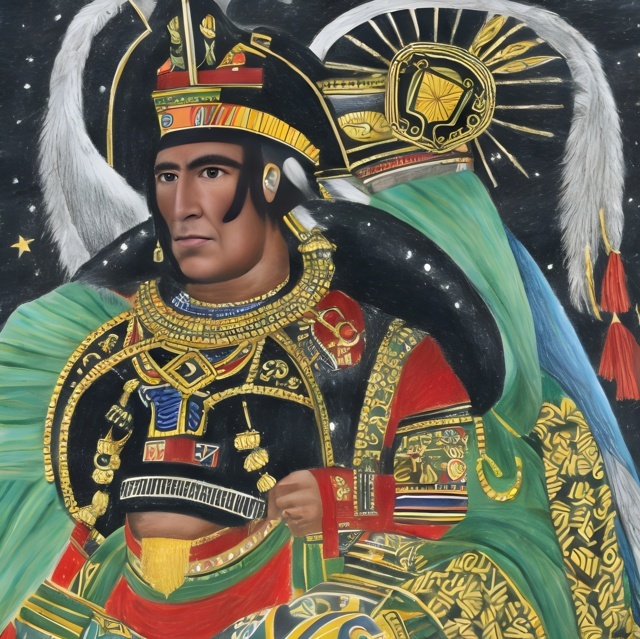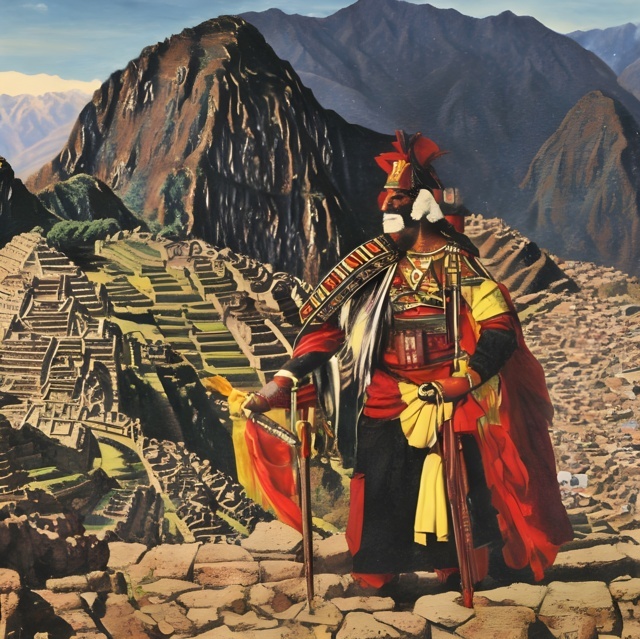The Legendary Founder of the Kingdom of Cuzco.
Manco Cápac was a legendary figure in Inca history, credited with founding the city of Cuzco and establishing the Inca Empire. He was born in the early 13th century, and he is said to have died in the early 14th century.
According to legend, Manco Cápac and his sister Mama Ocllo were the children of the sun god Inti. They were sent to earth by their father to found a city that would serve as a civilized centre for human progress. Manco Cápac was given a golden staff, and he was instructed to plant it in the ground where he found the most fertile soil. This would be the site of the new city.
Manco Cápac and Mama Ocllo traveled to the valley of Cuzco, where they found a spot that met their criteria. They planted the golden staff, and it sank into the ground up to its hilt. This was a sign that the gods had approved of their choice, and so Manco Cápac and Mama Ocllo began to build the city of Cuzco.
The Incas believed that Manco Cápac was a divine being, and they worshipped him as a god. He was credited with bringing civilization to the region, and he was seen as the founder of the Inca Empire. His story is a reminder of the importance of myth and legend in Inca culture.
In addition to the myths and legends, there is also some historical evidence to support the existence of Manco Cápac. Archaeological evidence suggests that the city of Cuzco was founded in the early 13th century, which is consistent with the timing of Manco Cápac’s legend. Additionally, some of the Incas’ cultural practices, such as their system of government and their religious beliefs, can be traced back to Manco Cápac’s time.
Manco Cápac’s legacy is still felt today. The city of Cuzco, which he founded, is still one of the most important cities of Peru. The Inca Empire, which he helped to create, was one of the most powerful empires in the Americas. And the myths and legends surrounding Manco Cápac continue to be told and retold, reminding people of the rich and complex history of the Incas.
Impact of Manco Cápac
The legacy of Manco Cápac is complex and far-reaching. He is credited with founding the city of Cuzco, which became the capital of the Inca Empire. He is also credited with establishing the Inca system of government, which was based on a complex hierarchy of rulers. Additionally, Manco Cápac is credited with spreading the Inca culture throughout the Andes region.
The Inca Empire was one of the most powerful empires in the Americas, and it reached its peak in the 15th century. The empire was known for its advanced agriculture, its sophisticated architecture, and its rich culture. The Incas were also known for their well-organized system of government, which was based on a complex hierarchy of rulers.
Manco Cápac’s legacy continues to be felt today in many ways. The city of Cuzco is still the capital of Peru, and it is a UNESCO World Heritage Site. The Inca Empire also left a legacy on the cultures of the Andes region. The Inca language, Quechua, is still spoken by millions of people today, and many of the Inca’s cultural practices, such as their agricultural techniques and their religious beliefs, are still followed by people in the Andes region.
In addition to these tangible legacies, Manco Cápac’s story also continues to inspire people today. He is a symbol of the Incas’ origins and their cultural identity. His legend reminds us of the importance of myth and legend in human culture, and it serves as a reminder of the rich and complex history of the Incas.
One of the most important impacts of Manco Cápac’s legacy is the way that it has shaped the way that the Incas see themselves. The Incas believe that they are descended from the sun god Inti, and they see Manco Cápac as their ancestor. This belief has given the Incas a strong sense of identity and purpose, and it has helped to unite them as a people.
Manco Cápac’s legacy is also important because it shows us the power of myth and legend. The story of Manco Cápac is a myth, but it is also a story that is rooted in history. This myth has helped to shape the Incas’ identity, and it has helped to preserve their culture.
Manco Cápac’s Legacy
Manco Cápac’s legacy is a complex and far-reaching one. He is a figure who is both real and mythical, and his story has been told and retold for centuries. His legacy continues to be felt today in many ways, both tangible and intangible.
On a tangible level, Manco Cápac is credited with founding the city of Cuzco, which became the capital of the Inca Empire. He is also credited with establishing the Inca system of government, which was based on a complex hierarchy of rulers. Additionally, Manco Cápac is credited with spreading the Inca culture throughout the Andes region.
On an intangible level, Manco Cápac’s legacy is perhaps even more important. He is a symbol of the Incas’ origins and their cultural identity. His legend reminds us of the importance of myth and legend in human culture, and it serves as a reminder of the rich and complex history of the Incas.
One of the most important impacts of Manco Cápac’s legacy is the way that it has shaped the way that the Incas see themselves. The Incas believe that they are descended from the sun god Inti, and they see Manco Cápac as their ancestor. This belief has given the Incas a strong sense of identity and purpose, and it has helped to unite them as a people.
Manco Cápac’s legacy is also important because it shows us the power of myth and legend. The story of Manco Cápac is a myth, but it is also a story that is rooted in history. This myth has helped to shape the Incas’ identity, and it has helped to preserve their culture.
In conclusion, Manco Cápac’s legacy is a complex and far-reaching one. He is a figure who is both real and mythical, and his story has been told and retold for centuries. His legacy continues to be felt today in many ways, both tangible and intangible. He is a reminder of the importance of myth and legend in human culture, and he serves as a reminder of the rich and complex history of the Incas.
References
– Hemming, John. The History of the Incas. 2nd ed., University of California Press, 2005
– D’Altroy, Terence N. The Incas: People of the Sun. Blackwell Publishing, 2002
– Fagan, Brian M. The Incas: A Civilization of the Andes. Thames & Hudson, 2005
– Murra, John V. The Incas: A Cultural History. Stanford University Press, 1980
– “Manco Cápac.” Wikipedia, Wikimedia Foundation, 2023, https://en.wikipedia.org/wiki/Manco_Capac
– Garcilaso de la Vega, El Inca. The Royal Commentaries of the Incas. Translated by Harold V. Livermore, University of Texas Press, 1966.
– Frame, Mary. The Incas: Lords of the Four Quarters. Thames & Hudson, 2007.
– Moseley, Michael E. Cuzco: The Sacred City of the Incas. Thames & Hudson, 2001.
Tags
Divi Meetup 2019, San Francisco
Related Articles
Unappreciated Greatness
Life and Legacy of Jahangir of the Mughal Empire. Jahangir ruled over one of the largest empires in human history during his lifetime, yet few people outside of South Asia have heard of him. I aim to shed light on the life and legacy of this remarkable figure,...
The Plague Doctor’s Diary
A Personal Account of the Turin Epidemic of 1656. I am writing this diary to record my experiences and observations as a plague doctor in Turin, the capital of the Duchy of Savoy, during the terrible epidemic that has afflicted this city and its surroundings since the...
The Timeless Beauty of Bustan
Unveiling the Secrets of Saadi Shirazi's Masterpiece.In the realm of Persian literature, few works have captured the essence of love, spirituality, and morality quite like Bustan (The Orchard) by Saadi Shirazi. This 13th-century masterpiece has left a lasting impact...
Stay Up to Date With The Latest News & Updates
Explore
Browse your topics of interest using our keyword list.
Join Our Newsletter
Sign-up to get an overview of our recent articles handpicked by our editors.
Follow Us
Follow our social media accounts to get instant notifications about our newly published articles.









